For anyone looking to get into the hobby, it’s recommended that you start collecting Lincoln Pennies. They are readily available, and they don’t cost that much. But what about the 1948 Lincoln Penny? What value does it offer?
According to the latest market price analysis, the 1948 Penny is worth between five and ten cents in circulated condition. The slightly better looking About Uncirculated examples are valued by the same company at between ten and 35 cents. A 1948 Lincoln Penny can fetch a wide range of prices, from as little as $0.50 to as much as $2,750, depending on its mint condition and specific variety.
Confusing? I know. But bear with me; we’ll discuss all these value estimates in detail. For now, consider the table below.
1948 Wheat Penny Valuation Chart
| Coin Condition | Estimated Value | ||
| 1948-P Wheat Penny | 1948-D Wheat Penny | 1948-S Wheat Penny | |
| Circulated
(G4 – XF40) |
$0.05 – $0.10 | $0.05 – $0.10 | $0.05 – $0.10 |
| About Uncirculated (AU50 – AU58+) | $0.10 – $0.35 | $0.10 – $0.35 | $0.10 – $0.35 |
| Uncirculated
(MS60 – MS64+) |
$0.50 -$14.00 | $0.50 – $12.00 | $0.05 – $7.50 |
| Brilliant Uncirculated (MS65 or higher) | $5 – $2,100 | $5 – $2,750 | $5 – $1,380 |
1948 Wheat Penny: Historical Background

Every coin is a historical relic regardless of when it was struck. Each penny is a time capsule of a moment in our nation’s history, and the 1948 Wheat Penny can tell us a lot about the minting process in the late ‘40s.
The 1948 Wheat Pennies have suffered a lot of spotting and staining over the 75 years they’ve spent in circulation. This effect could be the consequence of the technique the U.S. Mint used to prepare their planchets.
The Denver and San Francisco mints were notorious for their use of worn dies, and they ended up striking some not-so-sharp pennies. The Denver coins also suffered from staining and spotting. And while they may be difficult to find in the higher grades, mint state 1948-D Wheat pennies can be quite valuable.
The wearing of San Francisco’s dies was mostly due to heavy polishing. As a consequence, they yielded some prooflike coins with shallow features. The peripheral lettering was distorted in some coins. The “S” mint mark was affected, necessitating a repunched mint mark.
And these, folks, are the events that molded the 1948 Wheat Penny into what it is today. Now, let’s talk about physical features.
1948 Wheat Penny: Physical Features
To the untrained eye, all 1948 Pennies look the same. But those in the know are aware that pennies are struck in three color variations: Brown (which is the most common), Red, and Red-Brown. To achieve these variations of the bronze color, the U.S. Mint made their planchets from copper, tin, and zinc.

In what proportions? Perhaps the table below will answer your question:
1948 Wheat Penny: Physical Characteristics
| Physical Feature | Notes |
| Color | Red
Red-Brown Brown |
| Metallic Composition | 95% Copper
5% Mixture of Zinc and Tin |
| Weight | 3.11 grams |
| Diameter | 19.00 mm |
| Edge | Plain |
Obverse Design and Features
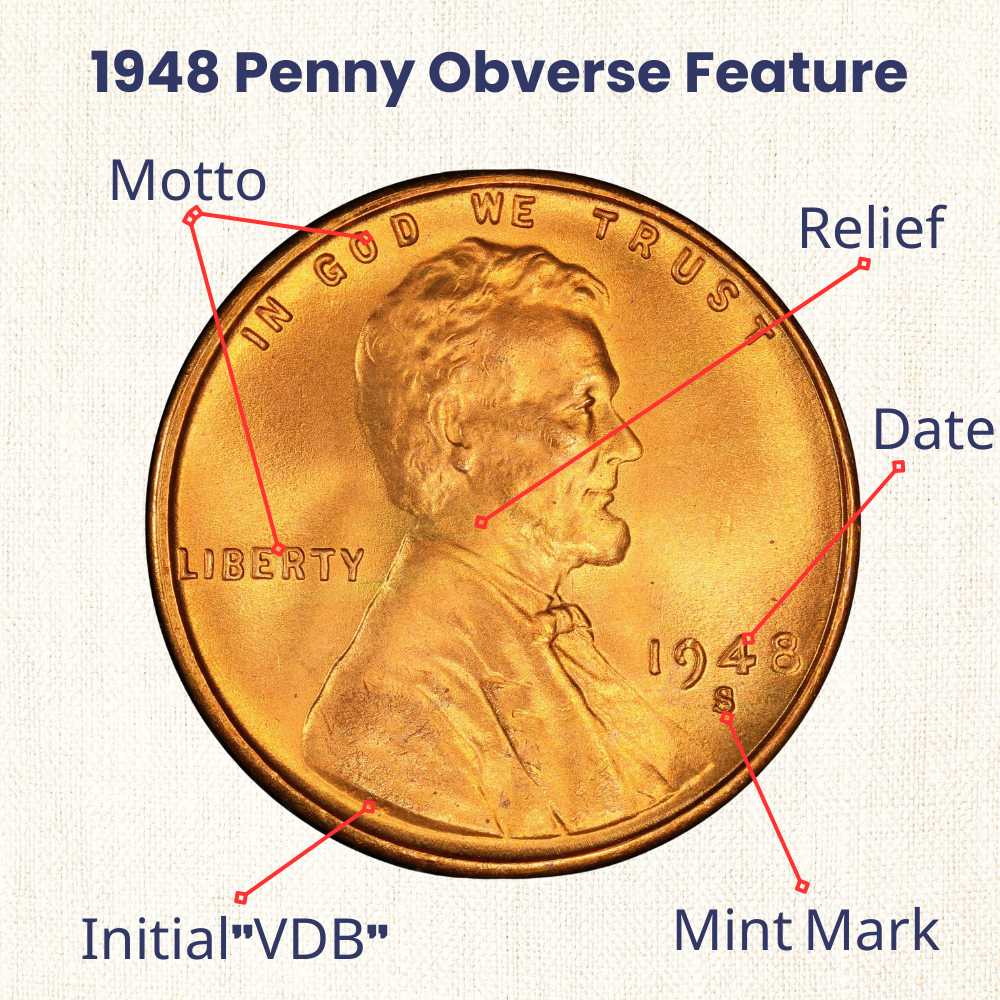
While the coin’s edge is plain, its faces certainly aren’t. And to find the objects to depict on the obverse, the U.S. Mint went with the 1909 design that was made by Victor D. Brenner.
Brenner’s design for the obverse included the following elements:
- The right-facing depiction of President Abraham Lincoln
- The inscription “LIBERTY“
- The legend “IN GOD WE TRUST.”
- The date “1948“
- The mint mark, “D,” “S,” or neither
- The designer’s initials, “VDB” (for Victor D. Brenner)
Reverse Design and Features
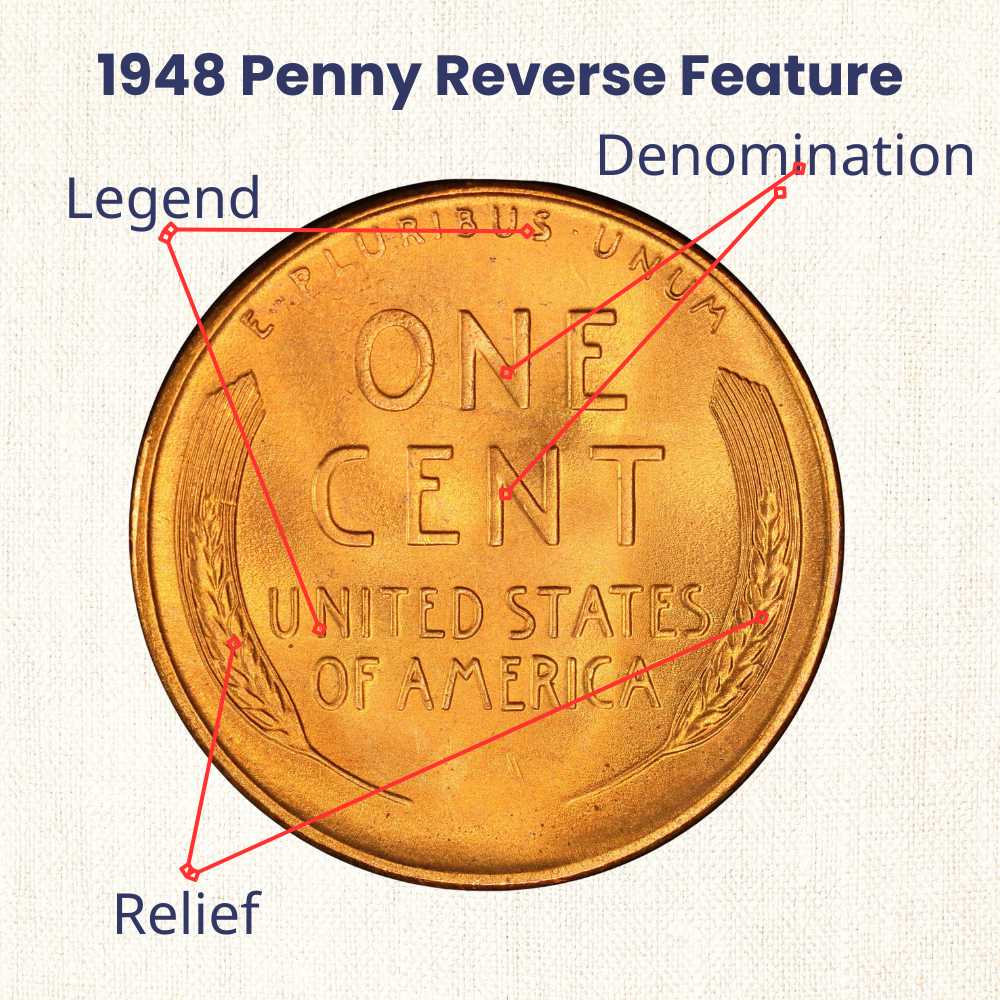
For the reverse, the U.S. Mint also went with the same 1909 design that has been gracing the Lincoln Penny since its inception. Surprise, surprise, Victor D. Brenner also made this design.
Brenner’s design for the Wheat Penny’s reverse included the following articles:
- Two wheat heads
- The denomination “ONE CENT“
- The country of issue “UNITED STATES OF AMERICA“
- The legend “E PLURIBUS UNUM”
1948 Wheat Penny: Varieties and Valuation
The 1948 Wheat Penny production involved the three big mints: Philadelphia, Denver, and San Francisco. And based on the mint marks they struck, we got three basic varieties. Below is a detailed account of the value of these varieties.
1948-P Wheat Penny Value
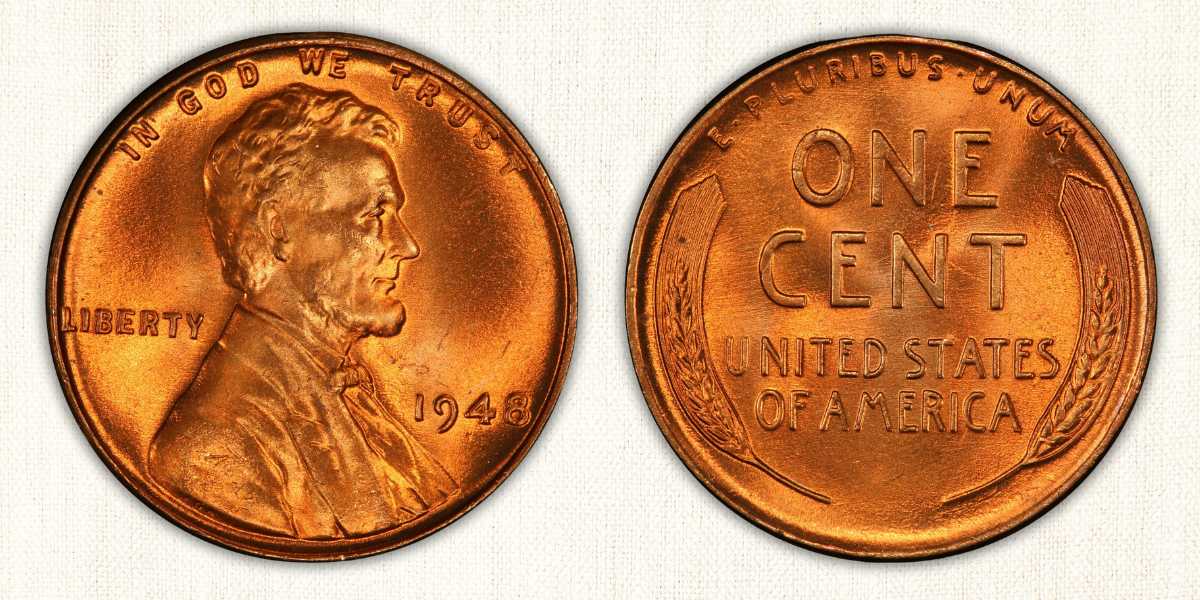
- U.S. Mint: Philadelphia
- Mintage: 317,570,000
- Mint Mark: None
It’s not uncommon for coins to disappear over the decades. For the 1948-P Wheat Penny, just enough time hasn’t passed yet to render the coin rare. Most of its population is made off circulated Brown 1948-P Wheat Pennies, which values between Five cents and ten cents.
The Red and Red-Brown varieties are almost impossible to find in circulated conditions. Most of the coins NGC graded were in mint condition with fairly high grades.
About Uncirculated 1948-P Wheat Pennies are also dominated by the Browns, which are estimate to be worth between 10 and 35 cents, depending on their condition. Remember, there are tons of these coins, and nobody bothers to grade them anymore.
In mint condition, you’ll find all sorts of pennies. The Brown variety is the most common and, as you would expect, the least valuable. In mint condition, a Brown 1948-P Wheat Penny is worth between $0.50 and $12.50. Why the low prices? NGC and PCGS has graded thousands of these coins and granted mint-state status to over 2,000 pennies.
The Red-Browns are slightly more valuable, with estimates that range between $3 and $23. Red 1948-P Wheat Pennies are the most desired which estimates value to be between $14 and $2,100.
Now let’s see how the value of these coins compare side-by-side:
| Coin Condition | Estimated Value | ||
| Brown | Red-Brown | Red | |
| Good (G4) | $0.05 | – | – |
| Very Good (VG8) | $0.05 | – | – |
| Fine (F12) | $0.05 | – | – |
| Very Fine (VF20) | $0.05 | – | – |
| Extremely Fine (XF40) | $0.10 | – | – |
| About Uncirculated (AU50) | $0.10 | – | – |
| About Uncirculated (AU58) | $0.25 | – | – |
| Uncirculated (MS60) | $0.50 | – | – |
| Brilliant Uncirculated (MS65) | $5 | $9 | $25 |
| Brilliant Uncirculated (MS66) | $12.50 | $23 | $120 |
| Brilliant Uncirculated (MS67) | – | – | $2,100 |
You must understand that the figures in the table above are only value estimates. In the open market, the actual price of a coin is driven by its demand. And demand can surge or drop in an instant. However, we found a few notable sales that will pique your interest.
| Variety | Grade | Sales Price | Auction Firm |
| Red | MS67RD | $10,350 | Heritage Auctions |
| Red | MS67RD | $9,775 | Heritage Auctions |
| Red | MS67RD | $8,225 | Heritage Auctions |
| Red | MS67RD | $7,167.50 | Heritage Auctions |
1948-D Wheat Penny Value
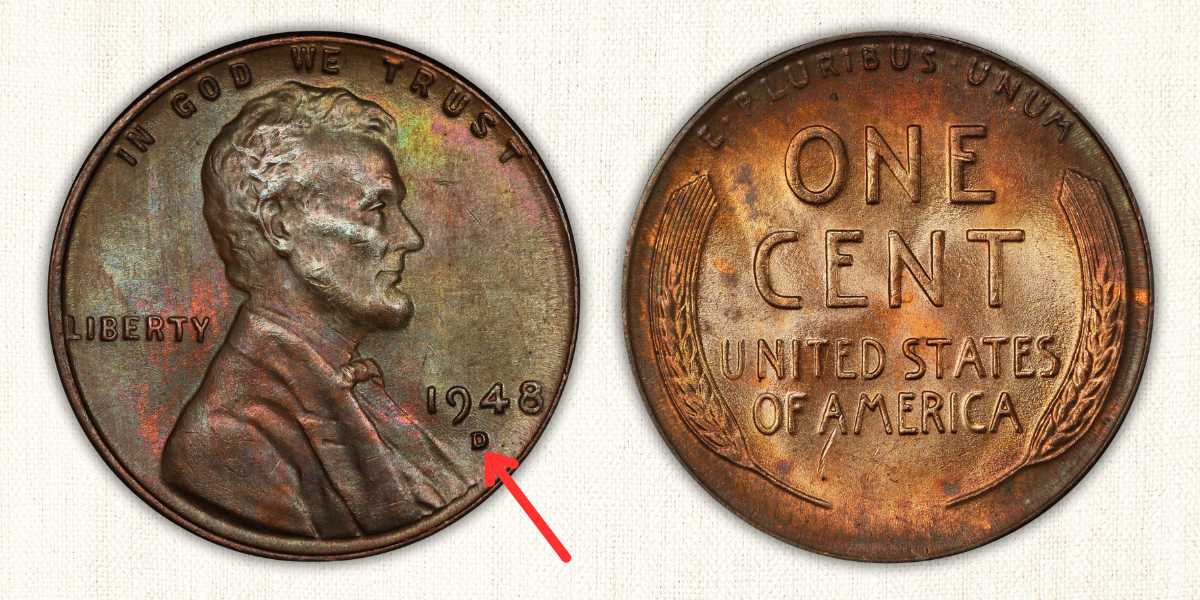
- U.S. Mint: Denver
- Mintage: 172,637,500
- Mint Mark: D
The narrative of value doesn’t change much when discussing the 1948-D Wheat Penny. The market is absolutely flooded with 1948-D Wheat Pennies, with the lower grades being claimed by Brown varieties. But how valuable are they?
Circulated Brown 1948-D Pennies are worth between five and ten cents. and the mint condition are worth between 10 and 35 cents, depending on their condition.
Brown 1948 Wheat Pennies can also be found in mint condition, and at this state, they can fetch between $0.50 and $32.50, again, depending on their condition.
The Reds and Red-Browns occupy the top tier, with most of them being in mint condition. The Red-Brown Pennies are slightly more valuable than the Browns, with values that range from $3 to $45 in mint condition. Their Red equivalents are the most valuable, as they are worth between $12 and $2,750. I guess digging through Grandma’s purse does pay, after all.
Let’s take a comparative approach and study the value of these varieties side-by-side.
| Coin Condition | Estimated Value | ||
| Brown | Red-Brown | Red | |
| Good (G4) | $0.05 | – | – |
| Very Good (VG8) | $0.05 | – | – |
| Fine (F12) | $0.05 | – | – |
| Very Fine (VF20) | $0.05 | – | – |
| Extremely Fine (XF40) | $0.10 | – | – |
| About Uncirculated (AU50) | $0.10 | – | – |
| About Uncirculated (AU58) | $0.25 | – | – |
| Uncirculated (MS60) | $0.50 | – | – |
| Brilliant Uncirculated (MS65) | $5 | $14 | $18 |
| Brilliant Uncirculated (MS67) | $32.50 | $45 | $900 |
In the open market, 1948-D Pennies can sell for thousands of dollars. There are some absolute gems out there, and below is a highlight of what they sold for.
| Variety | Grade | Sales Price | Auction Firm |
| Red | MS67+RD | $3,000 | Heritage Auctions |
| Red | MS67+RD | $2,115 | Heritage Auctions |
| Red | MS67+RD | $1,880 | Heritage Auctions |
| Red | MS67RD | $2,070 | Heritage Auctions |
1948-S Wheat Penny Value
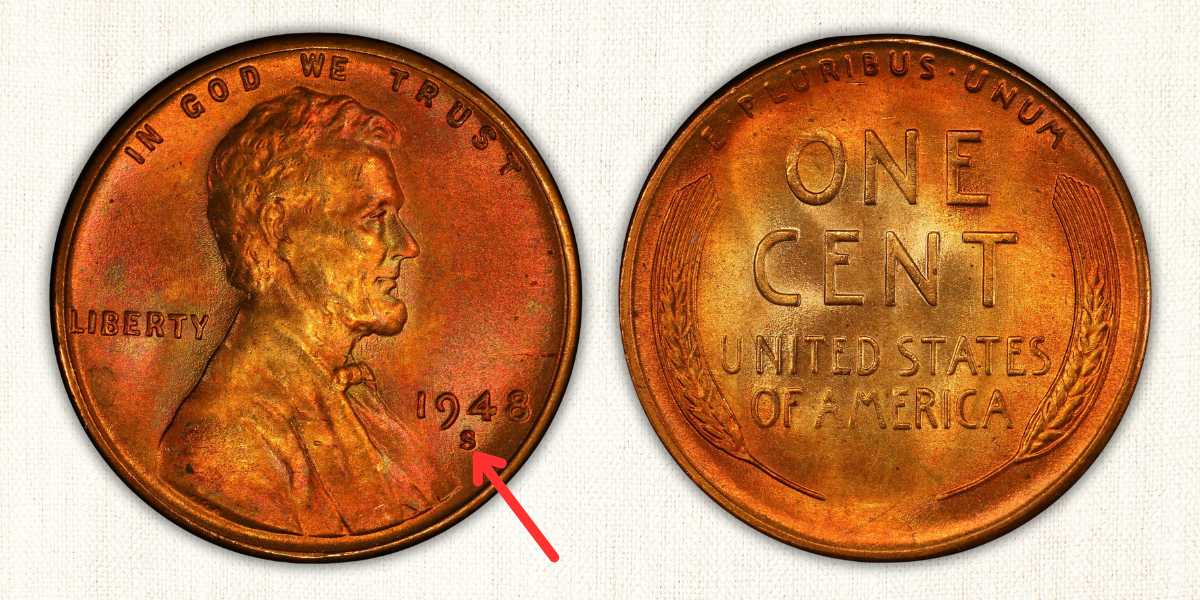
- U.S. Mint: San Francisco
- Mintage: 81,735,000
- Mint Mark: S
Striking Proof coins was not a priority in 1948, and the U.S. Mint skipped them altogether. The San Francisco Mint was instead tasked with making coins for commerce, just like its sister mints.
Here again, the story remains the same; the market is flooded with 1948-S Wheat Pennies. The lower grades of this San Francisco Penny are dominated by the brown variety, and it shows in their value.
In circulated condition, Brown 1948-S Pennies are worth between five and ten cents. Their better-looking counterparts in About Circulated condition are valued at between 10 and 35 cents depending on their condition.
In mint state, the Brown 1948 Penny is worth between $0.50 and $25.
Red and Red-Brown 1948 Lincoln Pennies are almost always in mint condition. NGC values Uncirculated Red-Brown 1948 Wheat Pennies at between $3 and $37. Their mint state counterparts of the same variety are estimated to be worth between $7.50 and $1,380.
While I’d love to outline the value of every grade of every variety of the 1948-S Wheat Penny, it would unnecessarily lengthen this post. So here’s a neat table to summarize that information.
| Coin Condition | Estimated Value | ||
| Brown | Red-Brown | Red | |
| Good (G4) | $0.05 | – | – |
| Very Good (VG8) | $0.05 | – | – |
| Fine (F12) | $0.05 | – | – |
| Very Fine (VF20) | $0.05 | – | – |
| Extremely Fine (XF40) | $0.10 | – | – |
| About Uncirculated (AU50) | $0.10 | – | – |
| About Uncirculated (AU58) | $0.25 | – | – |
| Uncirculated (MS60) | $0.50 | – | – |
| Brilliant Uncirculated (MS65) | $5 | $10.50 | $24 |
| Brilliant Uncirculated (MS67) | $25 | $37 | $155 |
While most of the value estimates above may be disappointing, I have to inform you that a handful of 1948-S examples have sold for more than $1,000. These are some of the most pristine examples of the coin. Below is a highlight of some notable sales that will lift your spirits.
| Variety | Grade | Sales Price | Auction Firm |
| Red | MS67+RD | $1,997.50 | Heritage Auctions |
| Red | MS67+RD | $1,175 | Legend RC |
| Red | MS67+RD | $1,072 | Legend RC |
| Red | MS67+RD | $1,057.50 | Legend RC |
1948 Wheat Penny: Valuable Error Coins
Historically, the Lincoln Penny has produced some very interesting error coins. We’ve seen everything from double ears to repunched mint marks. One can only wonder if the 1948 Wheat Penny has the same potential for error coins. So we investigated, and below are five valuable 1948 error coins.
1948-S/S Wheat Penny: Sold at $45.00
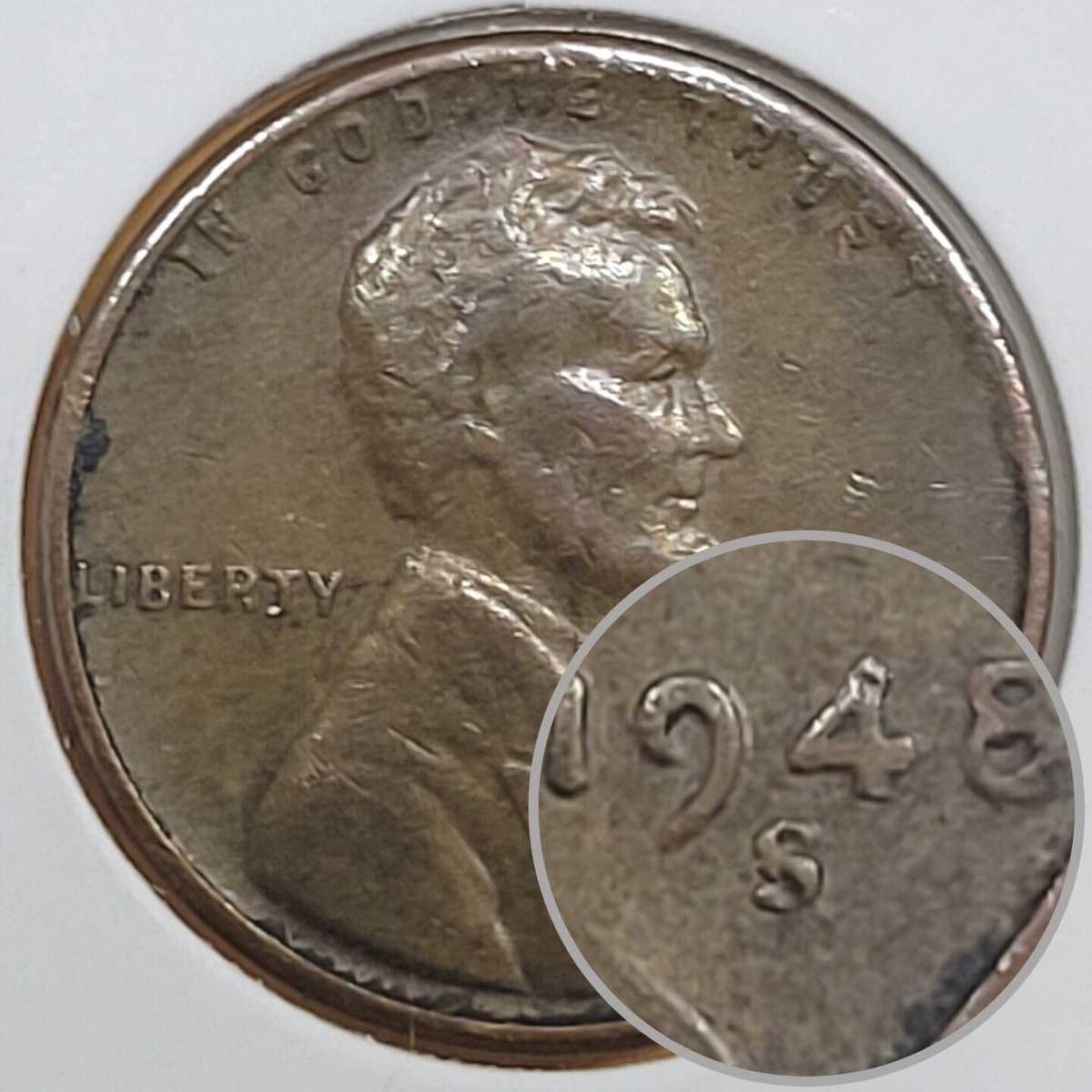
As I mentioned, the San Francisco Mint was notorious for overpolishing their dies. So bad was this practice that they struck coins with weak mint marks. As a reasonable remedy, they repunched some of their mint marks, and we got this gem of a coin.
1948-S with a Distorted Mint Mark: Selling for $350
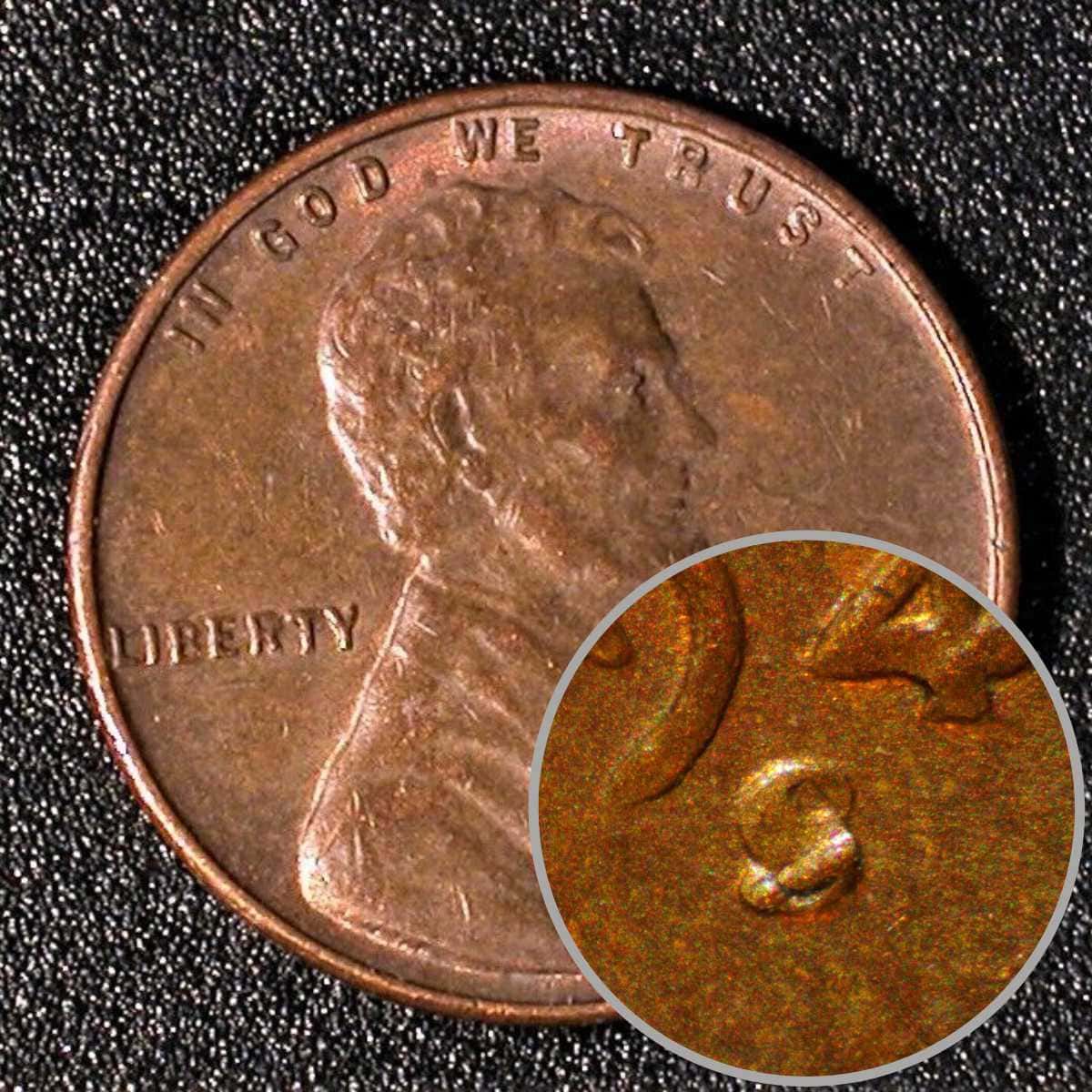
Here’s more evidence of the San Francisco Mint’s lack of quality. While the listing describes the error as a D over S over S, it’s hard to make out the “D” mint mark. It looks like a distorted “S.” While the coin isn’t graded, you can tell that it’s in About Used condition.
1948-P with Slight Clip: Selling for $8.41
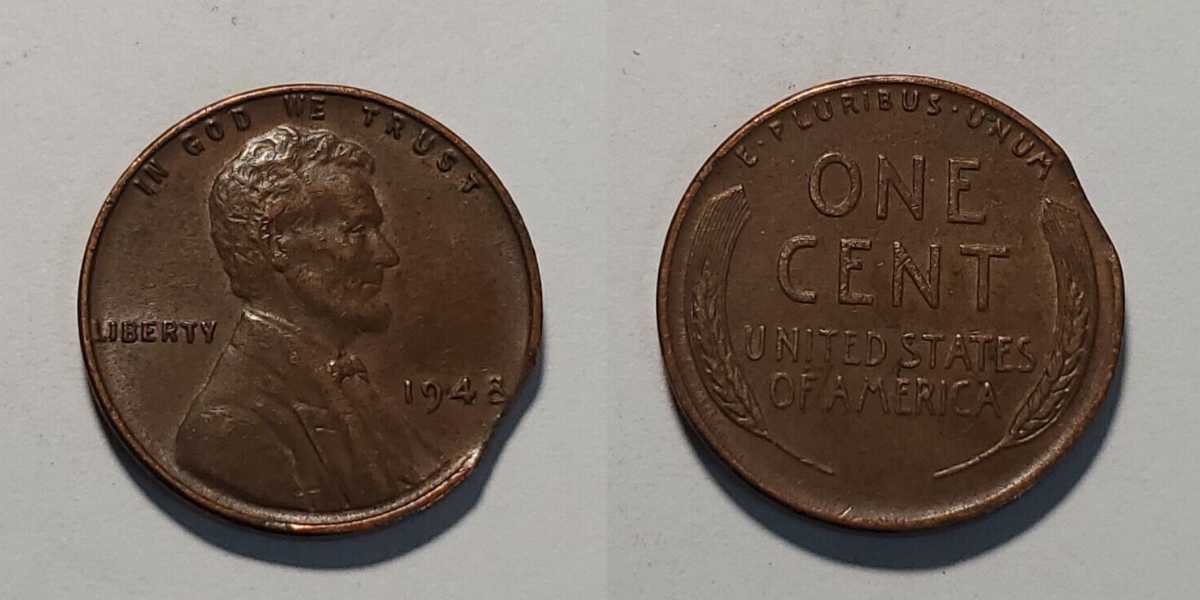
This coin has a small clip on the 4 o’clock position of the obverse. The clip has bitten through the rim and is just touching the date “1948.” Other than the error, this penny is bathed in chocolate brown and is highly suggestive of an About Uncirculated condition
1948 Wheat Penny: Is it Worth Collecting
The Lincoln Penny is a logical place to start for anyone interested in the hobby. It costs next to nothing to collect; there are some pretty awesome varieties and error coins.
Now, zooming into the 1948 Wheat Penny, it is easy to acquire, and average-grade coins are dirt cheap. It has some interesting error coins to get your feet wet in error collecting, but it does lack interesting varieties. The 1948 Wheat Penny is one of those coins that offers a little of everything to everyone.
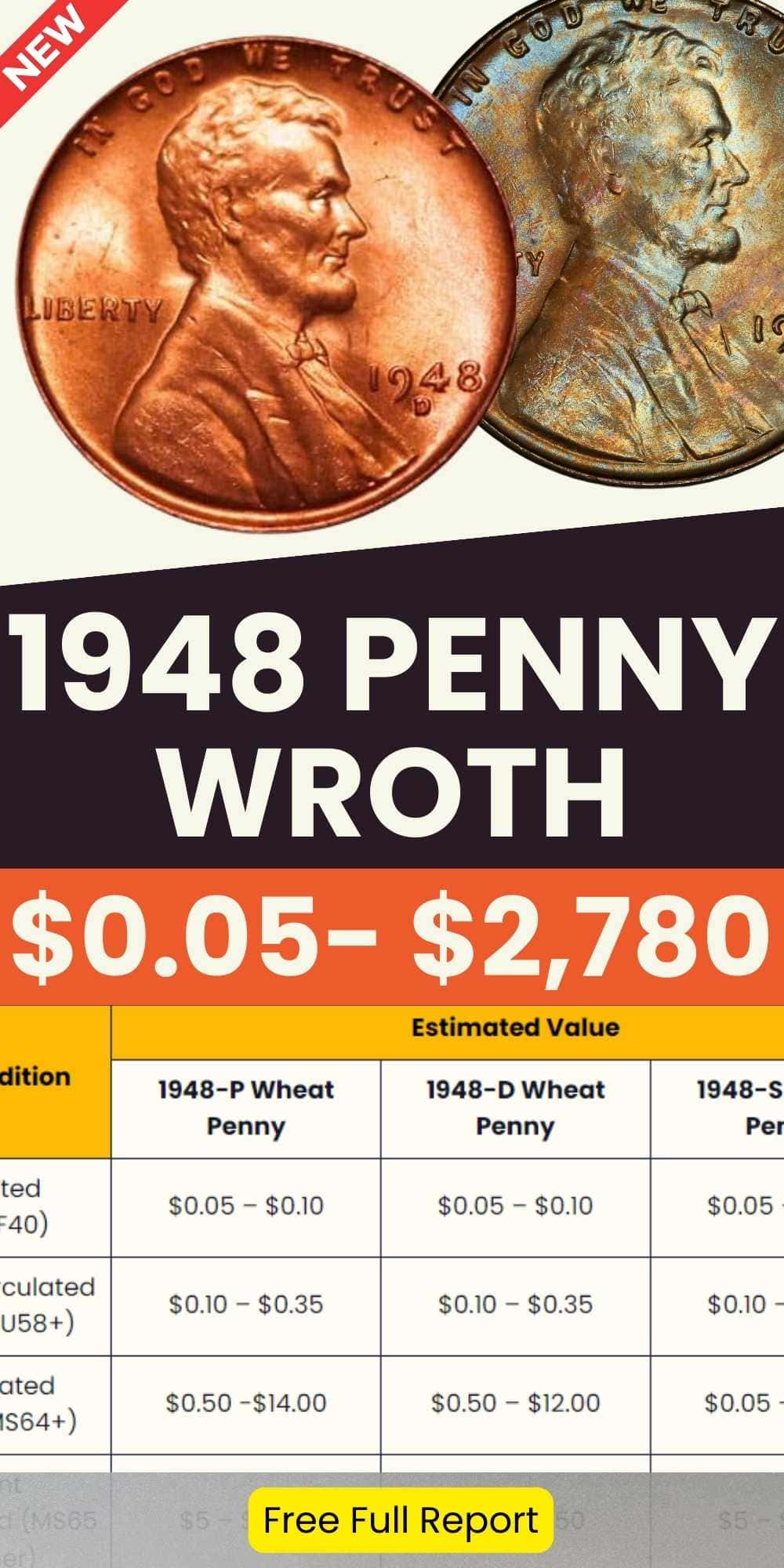

Jenson is a professional numismatist, a dedicated coin collector, a graduate of the College of Business at Oregon State, a life member of the American Numismatic Association (ANA), and an overall coin nerd. He is the founder of Coin Value List.
